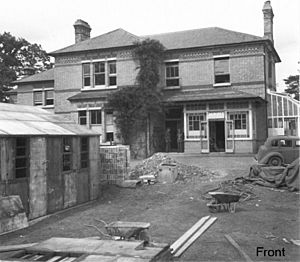Y service facts for kids
The "Y" service was a secret network of listening stations in Britain. These "Y-stations" collected important radio signals. This service was used during both the First World War and the Second World War. Different groups ran these stations, including the British Army, Navy, and Royal Air Force (RAF). Even the Foreign Office, which handles international relations, was involved. The General Post Office and the Marconi Company also helped, providing some listening stations on land and at sea. During the Second World War, there were over 600 listening devices used at Y-stations.
What the Y Service Did
The "Y" name came from "Wireless Interception," meaning they listened to radio messages. These stations usually did two main things. Some stations listened in to intercept the radio signals. Others worked to find out exactly where those signals were coming from. Sometimes, both jobs happened at the same place. The special hut for finding signal directions was often a bit away from the main listening building. This helped stop interference.
The Y-stations collected radio messages. If a message was secret or encrypted (scrambled into code), it was sent for processing. During World War II, these coded messages went to the Government Code and Cypher School at Bletchley Park. This was a famous place where codebreakers worked.
A large house called "Arkley View" near Barnet, London, was a big collection center during World War II. It gathered all the intercepted messages and sent them to Bletchley Park. Arkley View also had its own Y-station. Many messages were written down by hand. They were then rushed to Bletchley Park by motorcycle riders. Later, they were sent faster using special machines called teleprinters over telephone lines. Many people who enjoyed amateur radio helped the Y-stations. They were called "Voluntary Interceptors."
Finding Where Signals Came From
Specially built Y-stations were very good at finding the exact location of radio signals. This was called high-frequency direction finding (D/F). This skill became super important during the Battle of the Atlantic. Finding German U-boats (submarines) was vital for the Allies. Admiral Dönitz, the German U-boat leader, believed his submarines couldn't be found if they only sent short radio messages, under 30 seconds. But skilled D/F operators could pinpoint where a signal came from in as little as six seconds!
The Allies often used a design called the U-Adcock system for land-based D/F stations. This system had a small hut for operators. Around the hut were four tall, vertical antenna poles, about 10 feet high. These poles were usually placed like the points of a compass. Wires from the antennas ran underground into the hut. Inside, they connected to a special device called a goniometer and a radio receiver. This setup allowed operators to measure the direction of the signal's source. In the UK, some operators even worked in underground metal tanks. These stations were often in quiet, remote places, like the middle of farm fields. You can still see circular marks in fields near Goonhavern, Cornwall, from where these World War II D/F stations once stood.
Y Station Locations in Britain
- Beachy Head, Sussex
- Beaumanor Hall, near Loughborough, Leicestershire (run by the Army)
- Beeston Hill, Beeston Regis, Norfolk
- Bishop's Waltham, Hampshire (run by the Army)
- Brora, Sutherland
- RAF Canterbury, Kent
- RAF Cheadle, Cheadle, Staffordshire
- RAF Chicksands, Bedfordshire (run by the RAF)
- RAF Clophill, Bedfordshire
- Cromer, Norfolk
- Forest Moor, near Harrogate (run by the Army)
- G.P.O. Transatlantic Radiophone Station Kemback, near Cupar, Fife
- Denmark Hill, Camberwell (run by the Metropolitan Police and General Post Office (GPO) for the Foreign Office)
- Met Office Dunstable, Bedfordshire
- Felixstowe, Suffolk
- Gilnahirk, Belfast
- Gorleston, Norfolk
- Hall Place, Kent
- Harpenden, Hertfordshire (Army, No. 1 Special Wireless Group)
- Hawklaw, Fife
- HMS Flowerdown, Winchester, Hampshire
- HMS Forest Moor, Harrogate, Yorkshire
- Kedleston Hall, Derbyshire
- RAF Kingsdown, Hollywood Manor, West Kingsdown, Kent
- RAF Monks Risborough, Monks Risborough, Buckinghamshire
- Knockholt, Kent (run by the Foreign Office for non-Morse code signals)
- Markyate, Hertfordshire (run by the Army)
- Newbold Revel, RAF 'Y' Service Secret Intelligence and German Telephony Communications Base, Warwickshire.
- North Walsham, Norfolk
- Sandridge, Hertfordshire (run by the Foreign Office)
- Saxmundham, Suffolk
- Scarborough, Yorkshire (run by the Royal Navy)
- Shenley Brook End Milton Keynes (run by the Army)
- South Walsham, Norfolk
- Southwold, Suffolk
- Stockland Bristol, near Bridgwater, Somerset
- Stockton-on-Tees, Cleveland
- HMS Ventnor, Rew Down, Isle of Wight
- RAF Waddington, Lincolnshire
- Whitchurch, Shropshire in The Old Rectory, Claypit Street (run by the Foreign Office)
- Wick (run by the RAF)
- Wincombe, Donhead St Mary, Wiltshire (run by the GPO for the Foreign Office)
- Withernsea, East Yorkshire from a pub, the St. Leonards, now known as Captain Williams
- Woodcock Hill, Sandridge, St Albans



